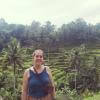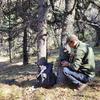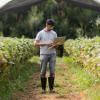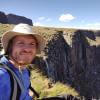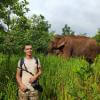Autonomous camera traps for insects provide a tool for long-term remote monitoring of insects. These systems bring together cameras, computer vision, and autonomous infrastructure such as solar panels, mini computers, and data telemetry to collect images of insects.
With increasing recognition of the importance of insects as the dominant component of almost all ecosystems, there are growing concerns that insect biodiversity has declined globally, with serious consequences for the ecosystem services on which we all depend.
Automated camera traps for insects offer one of the best practical and cost-effective solutions for more standardised monitoring of insects across the globe. However, to realise this we need interdisciplinary teams who can work together to develop the hardware systems, AI components, metadata standards, data analysis, and much more.
This WILDLABS group has been set up by people from around the world who have individually been tackling parts of this challenge and who believe we can do more by working together.
We hope you will become part of this group where we share our knowledge and expertise to advance this technology.
Check out Tom's Variety Hour talk for an introduction to this group.
Learn about Autonomous Camera Traps for Insects by checking out recordings of our webinar series:
- Hardware design of camera traps for moth monitoring
- Assessing the effectiveness of these autonomous systems in real-world settings, and comparing results with traditional monitoring methods
- Designing machine learning tools to process camera trap data automatically
- Developing automated camera systems for monitoring pollinators
- India-focused projects on insect monitoring
Meet the rest of the group and introduce yourself on our welcome thread - https://www.wildlabs.net/discussion/welcome-autonomous-camera-traps-insects-group
Group curators
- @tom_august
- | he/him
Computational ecologist with interests in computer vision, citizen science, open science, drones, acoustics, data viz, software engineering, public engagement



- 8 Resources
- 54 Discussions
- 5 Groups



- 9 Resources
- 2 Discussions
- 9 Groups
No showcases have been added to this group yet.
Ecologist at Noe NGO, Project manager in restauration, rewilding, and citizen sciences program for grassland ecosystems and wild pollinators

- 0 Resources
- 1 Discussions
- 7 Groups
- @capreolus
- | he/him
Capreolus e.U.
wildlife biologist with capreolus.at





- 1 Resources
- 78 Discussions
- 16 Groups
Research software engineer working in computer vision for animal behaviour
- 1 Resources
- 1 Discussions
- 13 Groups
Professor of Computer Science researching theory and application of technology to insect pollination and management in natural and agricultural ecosystems.
- 0 Resources
- 2 Discussions
- 1 Groups
- @ppalencia
- | Dr
I am Pablo Palencia, a postdoctoral researcher at Biodiversity Research Institute (IMIB). I am interested on develop and fine-tuning cutting-edge tools for wildlife management and conservation, wit a special mention of camera trapping ;)
- 0 Resources
- 0 Discussions
- 7 Groups
Natural Solutions
Computational ecologist - Engineer at Natural Solutions (France)



- 0 Resources
- 1 Discussions
- 13 Groups
- @Gcharron
- | Mr.
Cofounder of Outreach Robotics, I have a master in mechanical engineering and I thrive on developing new technology for field scientists using remote controlled robots.


- 1 Resources
- 15 Discussions
- 4 Groups
- @avilabon
- | He/Him/His
My name is Albert Vila, and I have a multidisciplinary background in earth sciences, design, and technology. I hold degrees in Environmental Sciences, GIS, Bioarchitecture, and Emerging Futures Design. My work focuses on biodiversity, natural areas, and technology.
- 0 Resources
- 0 Discussions
- 5 Groups
A researcher from Monash University working on developing Computer Vision facilitated insect monitoring systems for agriculture and entomology.


- 0 Resources
- 3 Discussions
- 2 Groups
Wildlife Drones
Wildlife Drones has developed the world’s most innovative radio animal-tracking system using drones so you can track your radio-tagged animals like never before.


- 18 Resources
- 8 Discussions
- 31 Groups
Research technician at the New Zealand Arthropod Collection. Interests include combining machine learning and computer vision in entomology.
- 0 Resources
- 0 Discussions
- 1 Groups
- 0 Resources
- 0 Discussions
- 3 Groups
This position focuses on the ecology aspect of the project, while a second PhD in Ilmenau will be dealing with programming/AI development. Because of the high temporal resolution of our data, we can investigate how land...
9 January 2023
a technology-led solution to understanding the honeybees of the wasp world
8 December 2022
In case you missed our webinar on Pollinator monitoring, here is the recording. We had presentations from three teams who will be presenting their work in designing automated monitoring tools for flower-visiting...
17 November 2022
Five articles that include conservation tech published at Mongabay
20 October 2022
Nice overview paper on technological advances to improve insect monitoring
16 September 2022
Job opening at the UK Centre for Ecology and Hydrology
19 August 2022
December 2023
event
November 2023
| Description | Activity | Replies | Groups | Updated |
|---|---|---|---|---|
| This is super cool! Me and @Hubertszcz and @briannajohns and several others are all working towards some big biodiversity monitoring projects for a large conservation project here... |
|
AI for Conservation, Autonomous Camera Traps for Insects, Camera Traps, Funding and Finance | 1 year 10 months ago | |
| Plasticy substances like polyester can be slippery, so I imagine that's why cotton is most often used. White is good for color correction, while still reflecting light pretty well... |
|
Autonomous Camera Traps for Insects | 1 year 11 months ago | |
| I agree, this would be great for canopy work! |
|
Autonomous Camera Traps for Insects, Camera Traps, Emerging Tech, Marine Conservation | 2 years ago | |
| Hi Ross, Where exactly did you put the UV paint? Was it on the petals or the actual middle of the flowers? I would recommend switching from sugar paste to sugar water... |
+8
|
Camera Traps, Autonomous Camera Traps for Insects | 2 years ago | |
| Greetings, everyone! I'm thrilled to join this wonderful community. I work as a postdoctoral researcher at MeBioS KU Leuven having recently completed my PhD on "Optical insect... |
+11
|
Autonomous Camera Traps for Insects | 2 years ago | |
| A new COST action has been announced which will focus on the use of computer vision for monitoring insects.InsectAI will run for 4 years... |
|
AI for Conservation, Autonomous Camera Traps for Insects, Camera Traps | 2 years 1 month ago | |
| Hi there,I am also trying to get some visuals from wildlife cameras of insects visiting insect hotels. Was wondering if you had gained any further information on which cameras... |
|
Autonomous Camera Traps for Insects | 2 years 2 months ago | |
| Further to @htarold 's excellent suggestion, you can replace that entire PCB with a simple USB breakout board (e.g. USB micro attached below) by removing the red wire and... |
|
Autonomous Camera Traps for Insects | 2 years 3 months ago | |
| Indeed, I'll be there too! I like to meet new conservation friends with morning runs, so I will likely organize a couple of runs, maybe one right near the conference, and... |
|
Acoustics, AI for Conservation, Autonomous Camera Traps for Insects, Camera Traps, Geospatial | 2 years 4 months ago | |
| Hi @ShwetaMukundan,this could be interesting for you:https://www.science.org/doi/10.1126/scirobotics.abb0839https://www.youtube.com/watch?v=VwiHf2T9bLUhttps://edition.cnn.com/2020... |
|
Autonomous Camera Traps for Insects, Sensors | 2 years 4 months ago | |
| Thank you so much for your reply! I'll look in to this now :) |
|
Acoustics, Autonomous Camera Traps for Insects, Camera Traps, Data management and processing tools, Drones, Geospatial, Software Development | 2 years 4 months ago | |
| Our project in very short is, setting up a sensor network for monitoring airborne biomass, mainly insects, birds and bats in near realtime, and to develop a forecast model to be... |
|
Autonomous Camera Traps for Insects, Animal Movement, Geospatial, Sensors | 2 years 4 months ago |


